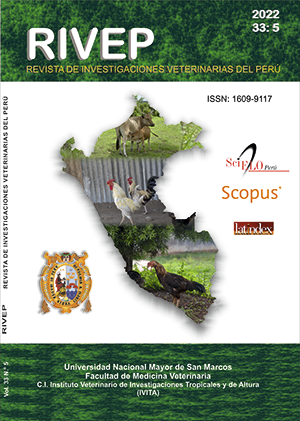Heavy metals and imposex in Thaisella chocolata (Gasteropoda: Muricidae) in Matarani, Arequipa, Peru
DOI:
https://doi.org/10.15381/rivep.v33i5.23793Keywords:
seawater, endocrine disruption, marine snail, imposex, heavy metals, sedimentAbstract
Marine ecosystems have been affected by contamination from heavy metals and antifouling organotin paints, where the latter generate the imposex phenomenon in marine gastropods. The presence of heavy metals and imposex in the marine snail Thaisella chocolata was evaluated at the "El Faro" artisanal fishing landing stage and at approximately 2 km from said pier, located in Matarani (Arequipa, Peru), during the winter and spring of 2021. In addition, heavy metals in the water and in the marine sediment were evaluated. Heavy metals in the water, sediment and muscle tissue samples of T. chocolata were compared with national and international standards for environmental quality. Boron in the water exceeded the norm in both areas in the spring. No heavy metal exceeded the regulations in the sediment. The values of As, Cd and Cu and Se in the tissues of T. chocolata exceeded some of the eight international standards for comparison. The risk to human health from the consumption of marine mollusks evidenced the absence of non-carcinogenic risk based on the Target risk quotient (THQ) and the Hazard index (HI) for heavy metals in T. chocolata. Shell size and penis length in males in T. chocolata were correlated. The percentages of imposex (9.6%) were classified as low. The RPLI (relative penile length index), the RPLIest (standardized RPLI), and the VSDI index (vas deferens sequence index) ranged from I to II in T. chocolata presenting low severity. It is suggested to continue monitoring the levels of heavy metals and imposex in T. chocolata in the southern zone of Peru to improve management efficiency and to enforce national and international regulations.
Downloads
Downloads
Published
Issue
Section
License
Copyright (c) 2022 Nathali Luna-Pacompea, Fátima Juárez-Laguna, Camila Jaén-Rodriguez, Lorena Alvariño, José Iannacone

This work is licensed under a Creative Commons Attribution 4.0 International License.
AUTHORS RETAIN THEIR RIGHTS:
a. Authors retain their trade mark rights and patent, and also on any process or procedure described in the article.
b. Authors retain their right to share, copy, distribute, perform and publicly communicate their article (eg, to place their article in an institutional repository or publish it in a book), with an acknowledgment of its initial publication in the Revista de Investigaciones Veterinarias del Perú (RIVEP).
c. Authors retain theirs right to make a subsequent publication of their work, to use the article or any part thereof (eg a compilation of his papers, lecture notes, thesis, or a book), always indicating the source of publication (the originator of the work, journal, volume, number and date).










